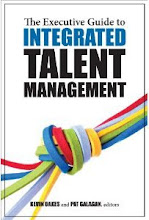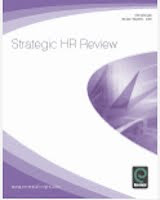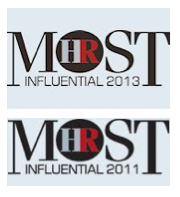 I've got a bit behind on my business reading but I've been catching up on the Harvard Business Review. I think the most relevant to this blog of all the recent articles I've been reading was April's on Reverse engineering Google's innovation machine.
I've got a bit behind on my business reading but I've been catching up on the Harvard Business Review. I think the most relevant to this blog of all the recent articles I've been reading was April's on Reverse engineering Google's innovation machine.
The article reviews some of Google's great human capital management practices which it credits towards the company's success (whilst pointing out that it is impossible to establish whether these practices have led to its success or its success enables these practices).
The practices include:
Building innovation into job descriptions: '20 percent time'
"One clear reason for Google’s success at innovation is that the company does what many others do not: budgets for it in employee time. New ideas at Google are often generated by employees, from the bottom up, in a prescribed system of time allocation. Technical employees are required to spend 80% of their time on the core search and advertising businesses, and 20% on technical projects of their own choosing."
HRZone provides more detail on this approach, as described by Google's HR Director for EMEA, Liane Hornsey:
"Employees' work structure follows a '70/20/10' model, an arrangement which, Hornsey says, is 'hugely important to anyone who works here'. This refers to a breakdown of the working week: 70 percent of the employee's time should be spent on the business, fulfilling the job role (which, incidentally, is very clearly defined - providing absolute clarity about the job description is essential as 'good people only fail if they do not know their role'). Ten percent of the schedule is time to do 'whatever [the employee] wants' – time for innovation and creativity, freedom to think.
Twenty percent of the time – or one day out of every week - she calls 'personal work', a period spent on personal development which will ultimately benefit the company. '[Staff] can work on whatever they want to work on, as long as it's in line with the mission [of Google]. This gives you time to develop'."
Twenty percent time / Google time has clearly ben a driver for the success of Google as well as Genentech and 3M but it still hasn't been copied widely elsewhere.
OK, it's a fairly different way of doing things but I still find its lack of uptake quite surprising given its impact on business results (eg accounting for 50% of new product / feature launches) and talent management: Google's overall HRD Stacy Sullivan explains that the policy is as important to attracting and retaining employees as it is to sparking fresh ideas: "We hear people asking about it in interviews. It’s a bit selling point. It makes people feel the company values the employees."
Eliminating friction at every turn: ensuring change can happen quickly and efficiently"Google’s approach to innovation is highly improvisational. Any engineer in the company has a chance to create a new product or feature. That individuals can have such influence has allowed Google not only to attract high-quality employees (including some of the world’s best computer scientists, statisticians, and economists) but also to create a large volume of new ideas and products."
This is a great example of coherence and alignment between strategy, HCM practices and employees: the strategy requires innovative practices which attract talent who enable the company to deepen its focus on innovation.
Letting the market choose: “crowdsourcing” its product strategy"The emphasis in this process is not on identifying the perfect offering, but rather on creating multiple potentially useful offerings and letting the market decide which are best. Even a modest fraction of Google’s more than 132 million users constitutes a massive test bed and focus group for evaluating the potential of new products."
Is this an HCM practice? I think it is because it demonstrates that Google are thinking about accessing the appropriate human capital wherever it exists - and this doesn't have to only be in employees.
Cultivating a taste for failure and chaos"Google executives appear to be undeterred by failure. In fact, Schmidt encourages it: “Please fail very quickly—so that you can try again” is how he described his outlook to the Economist. Similarly, Page told Fortune that he had praised an executive who made a several-million-dollar blunder: “‘I’m so glad you made this mistake. Because I want to run a company where we are moving too quickly and doing too much, not being too cautious and doing too little. If we don’t have any of these mistakes, we’re just not taking enough risk.’” Needless to say, that level of risk tolerance is rare in corporations, despite the widespread belief that error and innovation go hand in hand."
Supporting inspiration with data - making extensive, aggressive use of data and testing to support ideasThe article explains that Google takes an analytical, fact-based approach not only to its core business of page-rank algorithms but also to making any change in its web pages and deciding what new services to offer.
The article also refers briefly to Google's recruitment processes: "It continually modifies its hiring approach based on an ongoing analysis of which employees perform best and most embody the qualities of 'Googleness'."
ERE.net describes Google's use of algorithms in recruitment in more detail:
“The basic approach is quite simple. First, you survey current employees on a variety of characteristics and traits, including teamwork, biographical information, past experiences and accomplishments (i.e., have they started a company, written a book, won a championship, set a record).
Next, you statistically determine which of these many traits your top performers and most impactful employees' exhibit that differentiates them from bottom performing and average employees.
Finally, you develop an online survey to gather the predictive information from applicants. Then each candidate's biodata survey and resumes are screened electronically and given a score between zero and 100 based on how many of the top performance indicators each candidate possesses. (It's important to note that using biodata to screen candidates is not a new process, but is quite rare in companies that hire large numbers of professionals.)"
But I like Google's use of 'soft data' as well. In addition to a fairly innovative suggestion scheme (in which people can comment on and rate the ideas of other people), Google, seeks to tap the overall knowledge and intuition of its people through prediction markets:
"Another order of analysis involves Google’s use of nearly 300 prediction markets consisting of panels of employees. It uses the panels to assess customer demand for new products (“How many Gmail users will there be on January 1, 2009?”); company and product performance (“When will the first Android phone hit the market?”); competitor performance (“How many iPhones will Apple sell in the first year?”); and some just for fun (“Who will win the World Series?”)."
I think this is a really interesting approach, particularly in an organisation so focused on the use of information (in which according to a Harvard case study people aren't allowed to say 'I think' but instead must say 'The data suggest...'
So some great approaches supported, as the article notes, but a great culture, that even without the pool tables must make Google a truly great place to work - and no wonder they're so successful.
I'll finish my review of the article with one more quote:
"If a company actually embraced—rather than merely paid lip service to—the idea that its people are its most important asset, it would treat employees in much the way Google does."
I'd argue that companies should aim for the same degree of sophistication, but perhaps different practices may be appropriate (it's all about getting the alignment between strategy, practices and people).
But any company can develop these sophisticated approaches. As Google's Sullivan explain, they make sense for all workers, ranging from retail clerks to midlevel managers to top executives: "It could be anyone - just give them an opportunity to make a difference to your organisation".
So why aren't you doing them?
(Note, I've also commented on another of April's articles, 'What you can gain when you lose good people', on my
New Social Business blog.)
 In previous posts, I've written about the increasing importance of internal capability to business competitiveness.
In previous posts, I've written about the increasing importance of internal capability to business competitiveness.


































